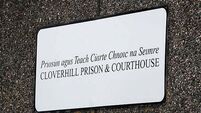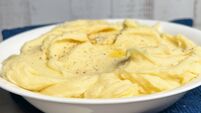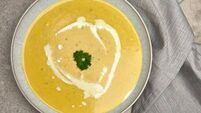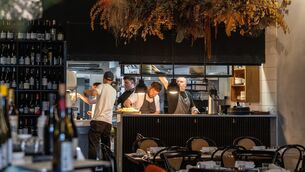Grow wild in the country

Furthermore, I’ve been coughing to an Olympic standard for the past week and reckon a drenching could see me out of this world altogether. Could we not just buy a bag of mushrooms at the next Centra?
Mycophagist ‘Big’ Bill O’Dea, of Mushroom Stuff, has been running increasingly popular mushroom hunts in Ireland and abroad since 1998. Today, he is taking us foraging around Kinnitty’s extensive grounds but, first, a luncheon lecture.
“There are old mushroom hunters and there are bold mushroom hunters,” says Bill with a sly grin, “but there are no old, bold mushroom hunters.” More people are killed each year eating poisonous mushrooms than are killed participating in extreme sports. More than a few wind up in our hospitals annually after failing to correctly identify magic mushrooms — we have 25 species of edible mushrooms in Ireland but you’d better make sure you can differentiate them from the almost 250 native species.
Even the delightful poetry of mushroom nomenclature — chanterelles, ceps, wood blewits, hedgehogs, honey fungus and puffballs, just some of the native edibles — takes a turn for the sinister when Bill starts itemising some of the fungal bad boys: Death Caps and Destroying Angels, Sulphur Tufts and that great deceiver, the False Chanterelle.
He gives us a rundown on the physical characteristics: shapes, caps, stems, gills or no, and so on, but in the same breath informs us we should NEVER eat any mushroom unless it has been identified by an expert. “Always keep a sample of what you eat,” says Bill, “that way the hospital doctors know what they’re dealing with.”
Foraging dates back to Neolithic hunter-gatherers while 18th century naturalists were the first to begin properly documenting wild edibles. Modern foraging in Ireland and Britain was reborn with the publication, in 1972, of Richard Mabey’s classic Food For Free. ‘Best Restaurant in the World’, Copenhagen’s Noma, features an almost entirely foraged menu and Bridgestone Chef of the Year, Enda McEvoy of Galway’s Aniar Restaurant — who has worked at Noma — has an equally strong commitment to using foraged foodstuffs.
“For me personally, it’s not a gimmick,” says McEvoy, who comes from a family of horticulturalists, “every vegetable we use was at one stage wild and an awful lot of what is still considered wild is edible. We try to showcase what is on offer locally as opposed to using imported stuff and, depending on the time of the year, there is only so much cultivated stuff available, so we look further afield in a limited environment.
“We’ve been harvesting an awful lot of wild rose petals which we leave in David Llewellyn’s Apple Balsamic Vinegar. It produces a fruity flavour but doesn’t overpower, we use it in sauces, to add a bit of piquancy or a high note because we don’t use any imported spices.
“We only use rapeseed oil and a lot of dairy which makes for very rich dishes and wild herbs such as sorrel are very citric, unique, fresh and counteract that richness, lighten it up.
“Foraging turns a walk into something extraordinary, it opens up your environment even if it’s not for edibles. Once you start identifying plants and their life cycles the whole natural world opens up, whether you’re out in the wilderness or just on a building site.”
Some, including Mabey in a recent interview, have been inclined to dismiss foraging as a ‘hobby’ for ‘foodies and ruralists’, but one area that cannot be dismissed as a middle-class fad is seaweed foraging which has a long tradition in Ireland. Stony soil, near rock, on many islands on our western seaboard was converted into arable land over generations by application of seaweed and Carageen, once a folk cure for chest ailments and a thickening agent for cooking is still widely used.
Bridgestone Guide Editor Sally McKenna, also one of the guides on West Cork-based Atlantic Seakayaking’s Seaweed Foraging trips, is a keen advocate of seaweed.
“It’s an elemental food, with huge health benefits — and it’s not just carrageen. We regularly collect about 10 varieties, using it for everything from making stocks, salads, lemonades, salts, cosmetics, handcream, massage oil, seaweed baths.
“But it’s a precious resource which needs to be respected and not abused. Seaweed in many other cultures is a very valued resource and as the world’s oceans become more and more polluted, clean Irish North Atlantic seaweed will become more and more valued.”
The growing Irish interest in wild mushrooms is a consequence of our monied years and the explosion of interest in all things culinary. While the forests and mountains of Europe have been crawling with mushroom hunters for generations, Irish would-be mycophagists are a comparatively more recent development.
Despite the rain, it seems we’re going ahead, many of us in wellies thoughtfully provided by the hotel. We’ve barely crossed the field to the wood before a first sighting, a Clouded Agaric.
“Very tasty,” says Bill, “but some people can have an allergic reaction to it.”
We skirt the edges of the woods, “always a good place to look,” says Bill, and are soon coming across all sorts of edibles and otherwise: Saffron Milkcaps, Blewits, a couple of Ceps, some Puffball variations and Honey Fungus.
Everyone is charmed when we chance upon our first Fly Agaric, the iconic red and white seat of many a storybook fairy or elf.
Just then the sky darkens, the mother and father of all downpours leaving no shelter. Waterproofs are useless, we can only head back to the hotel.
The management at Kinnitty most definitely run a tight ship, but whoever thought of laying out warm towels at the front door and hot toddies for us back in the Library Bar has a touch of the Mother Theresa about them and I’m still enveloped in both as Bill runs through our haul for the day. The edibles are quickly fried up by the kitchen, but most of us formerly fearless foragers, are a little tentative when it comes to sampling.
Later that evening we are treated to a magnificent eight-course foragers banquet. The first course is a mushroom trio: Girolles, Ceps & Oysters with Spinach Roulade. Bought mushrooms, of course, and, yes, it is absolutely wolfed down by all and sundry.
* www.mushroomstuff.com
* www.kinnittycastlehotel.com







